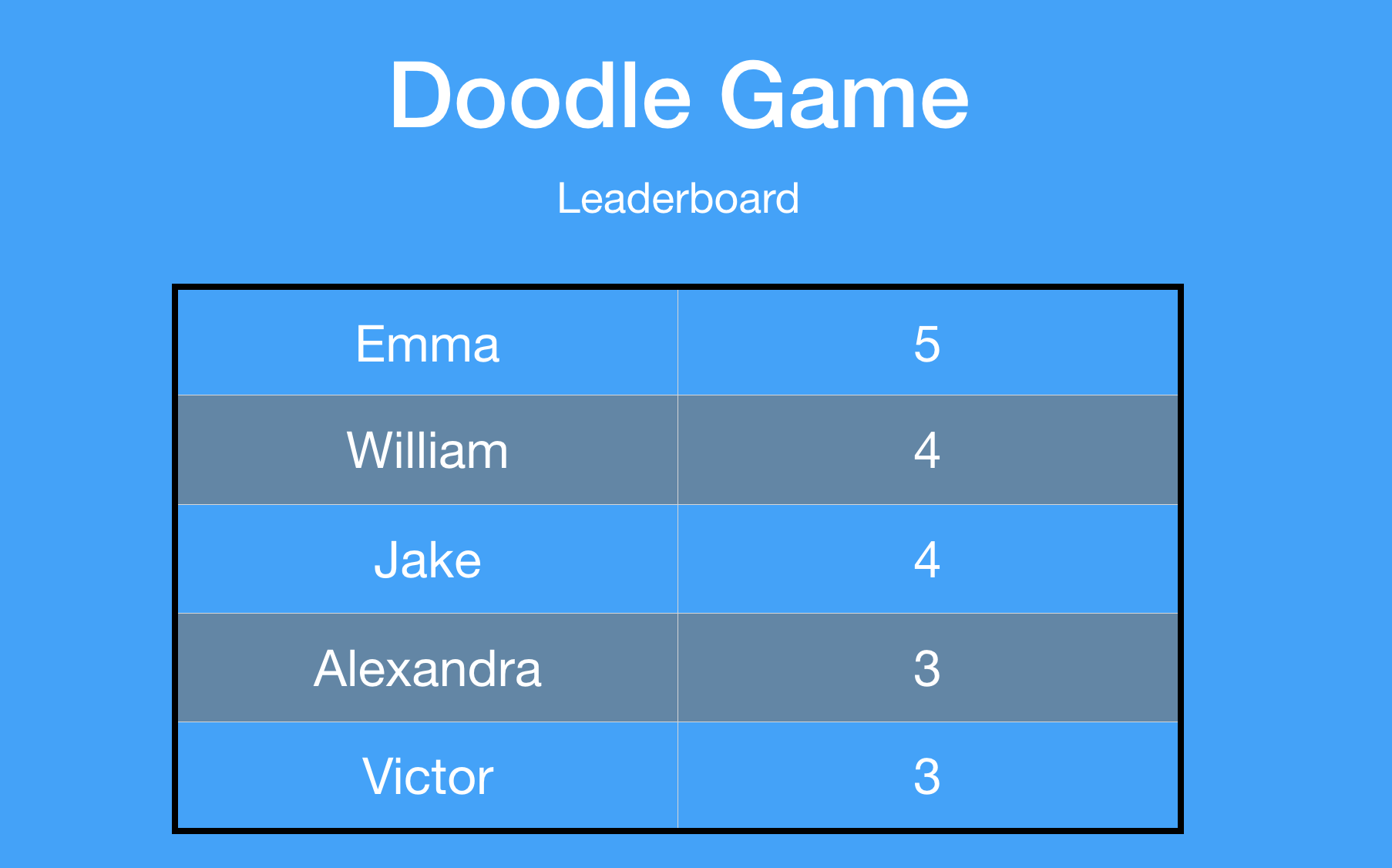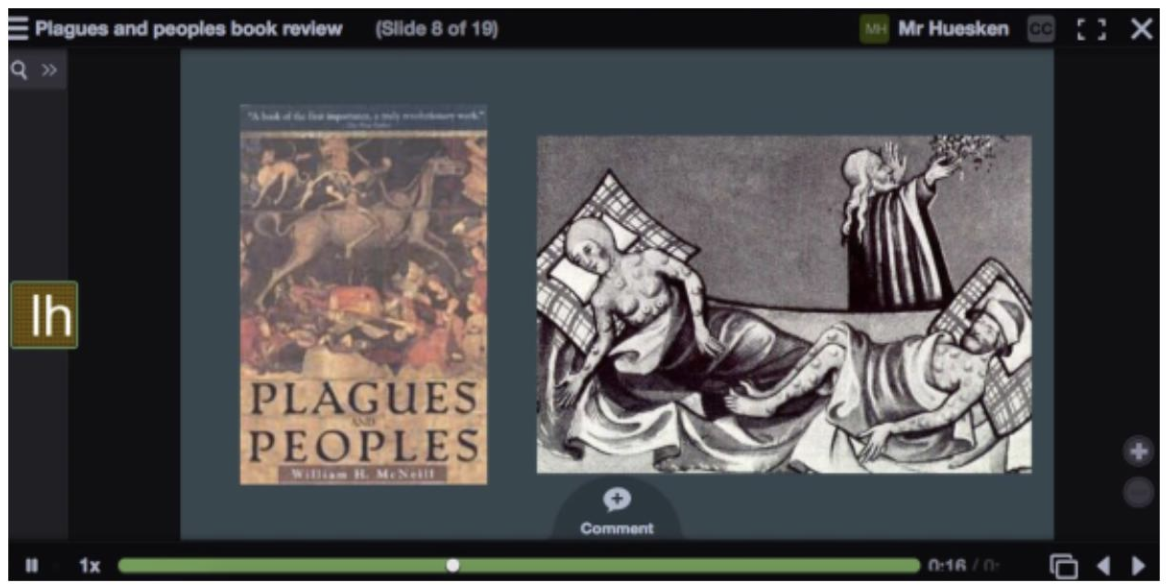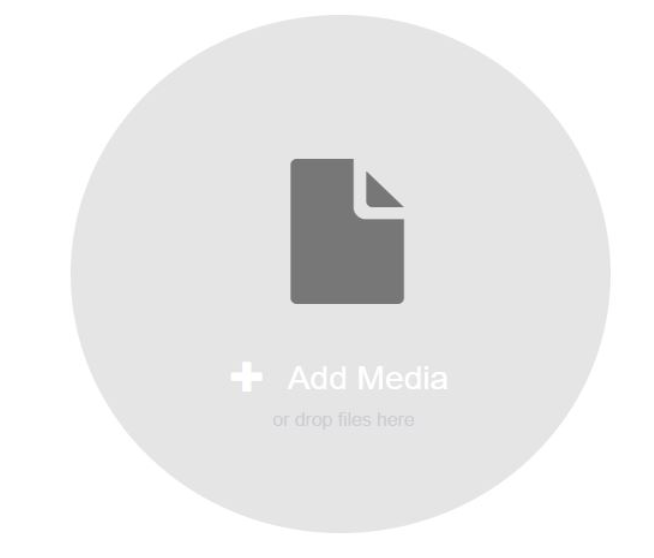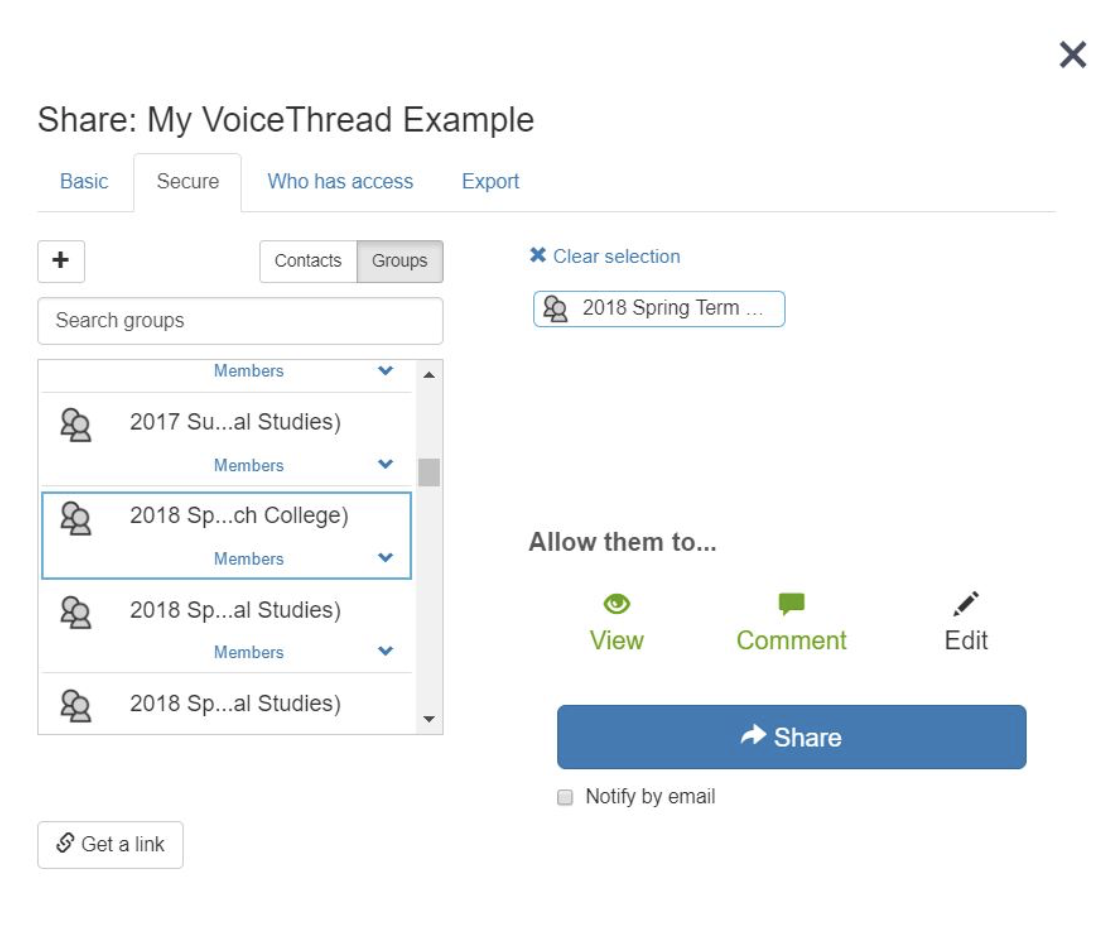Game-based learning is one of the most effective ways to get students excited about learning. Educators have been experimenting with games as learning tools for decades, but it isn’t always easy to design games using online tools. VoiceThread is not a gaming platform, but with a little creative lesson planning you can design activities that take advantage of gaming principles. Over the next few weeks, we will be showing different ways you can use these game-based learning principles for a variety of educational tasks. This post will explain how you can use VoiceThread to create simple games using the doodle tool to assess fact recall.
You can access the doodle tool once you start an audio or webcam comment on your VoiceThread. This tutorial will show you how it works:
Once you begin your audio or webcam comment, you can select different color pencils and toggle off the fading lines so they will remain on your slide for the duration of your comment.
Take a look at this VoiceThread to see doodle games for three different subjects (Geography, Math, Foreign Language):
Creating these types of games is simple. You only need to:
- Create slides using PowerPoint, Keynote, Word or any other document software you have on your computer.
- Upload those slides to your VoiceThread.
- Go to your playback settings and turn on comment moderation so the students cannot see each others’ answers.
- Record your instructions and demonstrate how it will look.
- Share the VoiceThread with your students.
Your students can then record their audio or webcam comments, choose their pencil color and decide if they want to toggle off the fading lines. They can trace their way from answer to answer. Once your students have completed the activity, you can either reveal their comments by clicking on the “closed eye” in their comment bubble or give them feedback on their answers using the private reply feature.
You may also want to tally the correct answers and post a slide that can serve as a leaderboard:

Games can be a fun way to assess factual knowledge and with VoiceThread, it is easy to do!
What separates good interaction from transformational interaction? Authentic engagement between people – student to teacher and peer to peer, not student to computer. We’re always working to make those interpersonal interactions easier in a VoiceThread.
Now you can insert your comments into a video exactly where you want them. Comments will appear in the video’s timeline as a small blue nib, allowing you to see where others have inserted them as well. The best part is that you don’t have to learn anything new. It just works.
You also have the option to pause while you are recording and then pick up that same comment right where you left off. After you click on “Stop Recording”, just click on “Record More” to keep going.
Let VoiceThread bring your online conversations to life by moving beyond text-only comments. Use your voice, video, and integrated annotations to engage and connect your students, person to person.


This is a guest post by educator and VoiceThreader, Preeti Singh.
Technology has revolutionized the world. The current generation of students learn better when they are taught with the aid of technology. There are numerous benefits in using technology, and teachers have to learn to apply it to their advantage in “doing things differently” and not just “doing different things.” I love technology and look for various tools to ‘hook’ my students into learning. One of the tools that I really like using with my students is VoiceThead.
Here are some of the ways I have used Voicethread in my teaching:
I started off the year by creating a Growth mindset for my students. When a student possesses a growth mindset, they can look at tasks with a “go-getter” attitude and are able to bounce back from challenges with an optimistic point of view. When they fail at something they understand that they can use that experience to learn new ways to achieve growth towards a goal. In this voice thread they talk about the occupation they would like to have when they grow up. Secondly, how they will work hard to overcome obstacles to reach their goals.
Growth mindset VoiceThread
Next, during our fantasy unit we learned about Greek Mythology and each student researched the Greek God of their choice for their presentation.
**Greek Mythology **
For Language Arts, each student was given a grammar word to illustrate and explain it with a sentence.
Grammar Words
The most exciting voice thread was when we celebrated cultural diversity in our classroom. We are all Americans but represent a culture that is unique to everyone. We had an Ethnic Food Festival where each student researched their heritage and then brought food from the country that their parents or ancestors came from.
**Ethnic Food Festival **
Using Voice thread has been very rewarding for my students and me. In the words of Bill Gates, “Technology is just a tool. In terms of getting the kids working together and motivating them, the teacher is the most important.”
Teaching is my passion especially when I integrate it with technology.
About the Author
Preeti Singh is a fourth grade teacher at Livingston Park Elementary School in North Brunswick. She has a Bachelor’s degree from Rutgers University and a Master’s degree in Education from Walden University, with a specialization in integrating technology in the classroom. She has also worked towards graduate credits in Math Education at Rutgers University. Preeti has a passion for integrating technology in the classroom and is always finding creative ways to teach her students. She is in the process of pursuing a Google Educator Certification. You can find her on twitter at: @preetisingh65 and @LPFantastic4th
This is a guest post by History teacher and VoiceThreader, Gerald G. Huesken Jr.

The great Polish-born American rabbi and Jewish leader Abraham Joshua Heschel once wrote that, “Speech has power. Words do not fade. What starts out as a sound, ends in a deed.” In the course of my educational career, when given the option between the written word and the spoken word, I have always found that the spoken word tends to carry more weight, meaning, and depth of understanding for my students then the traditional written reflection or research paper. As a high school instructor, providing power behind student “voice” is something that has often been a consideration with the projects and assignments I assign, while also trying to broaden my student’s academic horizons and experiment with emerging educational technology.
It is with these aspects in mind, that I have made VoiceThread one of the specific resources within my 21st Century classroom for promoting student voice and re-engaging my students in projects that needed a certain level of rejuvenation. I was introduced to VoiceThread during a graduate class I was taking and was intrigued by its blending of visual and audio elements. After some trial and error, I made VoiceThread a part of a traditional written assigned I give to my 10th and 11th Grade Honors World History students as part of their Semester Book Review Project.
See more of my Semester Book Review Project via my teacher website here.
In this project, students select a work of international historical fiction or non-fiction and consider how it relates back to our course content over the length of the semester. Historical insights, personal reflections, and unique historical discoveries all play a role in the student’s final discussion of the book, which they do via the VoiceThread platform. The result has been a much deeper discussion of student work and thought and a more enjoyable grading experience for me.
See some sample student projects via the following links =
* Cera’s project on The Lady and the Unicorn
* Alex’s project on Guns, Germs, and Steel
* Lauren’s project on 1215: The Year of Magna Carta
As a 21st Century educator, I highly recommend the use of the spoken word in student projects whether that is through public speaking, podcasting, or digital recording. Utilizing the spoken word gives student more of a direct ownership over their work in an age were traditional writing has become less engaging as well as the desire for higher quality of and demonstration of student understand. When a student put their voice to a project or topic, it carries power. VoiceThread serves as a perfect tool in this regard. As Rabbi Heschel said, speech truly does have far reaching power…
About the Author:
Mr. Gerald G. Huesken Jr. is a Government and Economics and World History teacher at Elizabethtown Area High School in Elizabethtown, Pennsylvania. A veteran of over a decade in the classroom, Mr. Huesken is a graduate of Shippensburg University and holds a Masters degree in History from Millersville University. Currently, he is concluding a second Masters degree program through Wilkes University in Online Education and is perusing a digital teacher certification from the Pennsylvania Department of Education. Feel free to connect with Mr. Huesken via LinkedIn or follow him on Twitter at @MrHuesken.
This is a guest post by educator and VoiceThreader, Curtis Izen.
In my online and f2f business information courses, I have used VoiceThread for a variety of assignments. This includes an “ice breaker” , transforming discussion boards, group PowerPoint, individual research assignments to be shared for the entire class to learn from, and using comment moderation in a Microsoft Excel assignment.
Through all these assignments, I created the initial VoiceThread. It was the students task to comment on slides within. I found that by giving them the foundation, commenting would be rather intuitive. I continued this approach, but wanted the students to take a more dynamic methodology. I tasked them to create their own VoiceThread from scratch; subsequently sharing it with the entire class.
The assignment I proposed was a semester long project, with 2 distinct requirements. For the first half of the term, they were asked to research and write a rigorous research paper on a topic of their interest (in my case it was technology). Once their paper was graded, the students were then asked to create their own VoiceThread on the same topic they researched. Since I wasn’t giving them the initial VoiceThread to comment on, I wanted to come up with a pedagogy that would be helpful for both the entire class and themselves.
Their first instructions were to create a PowerPoint presentation which would be displayed in the lobby of the school. They could include mashups, but not any voiceovers (VoiceThread doesn’t carry these over when created).
Once they completed their PowerPoint, they saved the file in PDF format (this works best when converted to VoiceThread). The next step for the students was to create a VoiceThread. On the menu page of my LMS, I created a button linked to their VoiceThread home page (The student first needs to be in a VoiceThread within their LMS or they will be asked to sign into VoiceThread). Once they are at their homepage, they can click on the “Create” link. Subsequently, they click on “Add Media” and choose their saved PDF file. After a short period, the VoiceThread gets generated.


Once the VoiceThread is created, students can now edit their slides by rearranging, deleting or even inserting new slides that may have been missed. Commenting in video or voice (no text), doodling and multi-slide (M/5) comments were encouraged making the VoiceThread engaging. The final step for the students was to share their VoiceThread with the entire class. View and Commenting are active, but editing is not enabled so other students are unable to modify the content.

At this time, the entire class can start to see everyone’s VoiceThread populate. The last requirement for all students was to comment on 2 other VoiceThreads (they need to comment first on VoiceThreads that have no initial comments). I require that the last slide of everyone’s VoiceThread be a comment slide (I supply the .jpg) to make it consistent across the board.

I have found this assignment to be a creative and effective way for students to complete a semester long project. If you are looking for ways to give your students greater control of VoiceThread, having them own it could be the solution.
About the Author:

This is a guest post by 3rd Grade Teacher and VoiceThreader, Traci Blazosky.
Every year, my students celebrate Major League Baseball (MLB) day. This day happens in my classroom on opening day for the Pittsburgh Pirates. The entire day is devoted to baseball related activities that all align with the Common Core. For ELA, we read a poem by Ernest L. Thayer, titled Casey at the Bat and complete a comprehension activity. In math, students complete a MLB stadium number challenge in which they solve problems involving the four operations and translate information from a chart. To test their geography skills, students are challenged to use a map of the US to locate and label the American League and National League ballparks.
My favorite activity of the day, though, is the MLB Franchise collaborative project. For this project, students must demonstrate creative thinking as they plan, design, and work to establish a new MLB franchise. The geography activity is important for this project, as it helps guide their planning. Seeing where there are no ballparks is key when pitching their idea to the MLB Commissioner. Working in small groups, students use laptops to research where they may want to locate their ballpark. They take into account the area and characteristics/features of the state. From this point, colors and mascots are chosen based on their research. Students then divide tasks, and begin the process of creating their logo. Discussion on promotions to draw a crowd take place, and then the final step is to write a persuasive letter to the MLB Commissioner in hopes of becoming the next new franchise.
When the planning and creating process is complete, it’s time to publish. Voicethread has been my go-to tool for sharing my students’ projects for the last seven years. What better way to publish work for an audience and enable students to hear feedback from others than by using Voicethread? The students uploaded their images with ease, and began recording. The process was quick and easy. Now, they wait in eager anticipation to see who the winner will be.
Voicethread allows my students to share their voice and grow as fluent readers. Recording has brought many of my most passive students out of their shell, and has boosted their self- confidence when reading for an audience.
Please check out our Voicethread below, and vote for your favorite team!
About the Author:
Traci Blazosky is a third grade teacher at Clarion Area School District. She is also an adjunct instructor for the Instructional Media graduate program at Wilkes University of PA. She is a STAR Discovery Educator, and was named a Discovery Educator Guru in “Creative Construction with Multimedia.” In 2013 she received the Academy of Arts and Sciences BAMMY Award for Elementary Classroom Teacher, and in 2009 received the PAECT Teacher of the Year award. Traci has a passion for technology and education, and loves exploring new technology for meaningful use in the classroom. You can find her on Twitter at: @kti_traci.
Any teacher who asks students to read materials understands the important of reading comprehension. Whether you are an elementary school teacher who teaches reading, a foreign language teacher who works to build fluency, or a history teacher who wants students to learn about WWII from their textbook, comprehension is vital to the process.
As Daniel Willingham points out in his NY Times Op-Ed, comprehension isn’t simply about decoding; it’s also about vocabulary and context. Typically, teachers who are looking to assess reading comprehension ask students to read a passage, then have them answer questions about the text. Many of these assessments are pre-packaged activities in workbooks or practice tests. VoiceThread can allow educators to construct their own assessments that include these additional components.

The good news is that creating this type of rich assessment is easy with VoiceThread. Here’s how you can do it:
- Find a passage you want students to read. Go through the passage, noting the vocabulary or context issues students may find confusing.
- Find images that can serve to explain the tricky words or unclear context involved in the passage.
- Create a slide with the passage you want students to read. This can be done by pasting the passage into a PPT or Keynote presentation, a Word document or simply taking a screenshot of the text and saving the image.
- Upload the document or slide you created to your VoiceThread, along with the images for the vocabulary words and context cues they will need for background information.
- Record your instructions for the students, asking them the comprehension, vocabulary and context questions.
- Students can then record their answers right on each slide. (If you don’t want students to hear each others’ answers, simply turn on Comment Moderation.)
This type of assignment can not only build knowledge for your students, but it can also help give you a clearer picture about their true ability to comprehend the passages. VoiceThread empowers teachers to use visuals and a more human interaction that workbooks fail to provide. Reading comprehension assessments don’t need to be stuck in a text-only environment, and neither do your students. Give VoiceThread a try and let us know the difference it can make!
This is a guest post written by a team of teachers and VoiceThreaders at the South Burlington School District.
Our students have a lot to say. Imagine all of the opinions swirling around our topic of Bioethics in a tenth grade general science class! How could we hear from each of the 85 learners in our 4 sections of Biology, and allow them to share thoughts with students in other sections? VoiceThread provided the obvious answer.
We offered them choice between compelling topics and provided suggested resource materials, so the focus could remain on accurate content rather than research skills. Students joined self-selected groups. The teacher had already presented information about DNA and Genetic testing. Rather than a traditional test, we decided to allow students to give voice to their ideas as they explored challenging topics in the realm of bioethics, using the scientific information they had learned in class. VoiceThread allowed them to follow a formula: state the dilemma, explain the science behind it, define the ‘pros’ of the issue, and give clarity about the ‘cons’ of the issue. Ask colleagues: What do YOU think?
Finding a compelling image was fairly easy. Creating a brief script with a group of 4 students was a bit more challenging. We wanted them to be able to record their voices in a fairly casual way; to be accurate but not too scripted. After two class periods of reading, further research, and composition of a statement, we were ready to record. Finding a quiet place for small groups became a challenge, but hallways, closets, and empty classrooms provided some answers.
Instead of the boring class presentations where student after student rises to explain their work, we had students simply review their colleagues’ VoiceThreads, and post comments explaining their opinion on the controversial topic. For the students who hate to stand up in front of a group to share their projects, this was a gift, indeed. Every student could hear what every ‘expert’ had to say on the topic, then hear their classmates’ opinions, and then add their own voice. By the way, we insisted on using their voice, because strings of typed comments are simply tiring and uninspiring.
The exciting next step was to share the Threads among the four biology classes. Now students could hear how ‘experts’ in other classes approached a topic, and to do a brief tally of how other students reacted to each topic. Students were able to chime in on conversations among learners who weren’t even in their own class! It was safe, yet exciting, to be part of a conversation where colleagues were expressing very personal beliefs. In fact, even on a snow day students were making comments on Threads! That’s pretty clear evidence that the project was a success.
Simultaneously, our students all have Personal Learning Plans, which include a statement of their core values. The final step of the project was for students to consider the ways in which their core values helped them make decisions around bioethics. In a couple of cases students actually modified or added to their values, recognizing their earlier lists were too superficial to be truly meaningful:
“My core values and VoiceThread really helped me express my ideas and helped me make decisions in the bioethics dilemmas because I felt like in order for science and biology to be successful we have to persevere and improve in our research, and improving and success are two of my core values. When replying to other teams’ dilemmas I needed to reevaluate (or add) to my core values list and I also had to restate my ideas on even my own project because other peoples comments changed my mind and persuaded me.”
Another student added:
“My core values helped me make decisions in bioethical dilemmas because they helped me clearly choose a side in most of the decisions I was faced with. ..Voicethread helped my critical thinking process because it helped me learn about new things, and gave me an opinion on both sides of a problem. For example, when I listened to golden rice, I heard arguments for both sides of the dilemma. This made me think about my viewpoints, which lead to further thinking and better decision making. Also, VoiceThread helped me do better work because everyone had an equal voice, and once it was uploaded I could go back to it and listen at anytime of day. These are the reasons technology helped my critical thinking, and why my core values helped me make decisions in bioethical dilemmas.”
VoiceThread not only allowed students to participate equally in learning science and forming opinions but in extending that learning to real life. It allows learning to happen any time, any place, any path, at any pace.
About the Authors:
Rich Wise is a Science teacher who has been teaching science for 40 years and is retiring in June.
*Heidi Western is an ELL teacher who began working with English Learners in South Burlington in 1999. She works within science classes to broaden all students’ academic language skills and supports the ELLs in a science literacy lab. *
Lauren Parren is the Tech Integration Coach. Lauren joined the SBHS staff 3 years ago, coming full circle after doing her student teaching there over 40 years ago. She works with teachers to explore the intersection of technology and pedagogy to create meaningful learning opportunities.
Students with Dyslexia are one of the most underserved student populations in our schools. When we discuss Universal Design and accessibility for students, we typically forget about students who struggle with text. The International Dyslexia Association has spent time working to help these students and recently shared a Structured Literacy approach that works well with VoiceThread.

Photo credit: TheDyslexicBook.com.
Here are some tips for using VoiceThread within a Structured Literacy framework:
Phonology
“Phonological awareness includes rhyming, counting words in spoken sentence, and clapping syllables in spoken words.”
How VoiceThread can help: Teachers can upload slides with sentences and ask students to record themselves reading each syllable and clapping to emphasize the breaks in the sounds.
Sound-Symbol Association
“Sound-symbol association must be taught and mastered in two directions: visual to auditory (reading) and auditory to visual (spelling).”
How VoiceThread can help: Teachers can upload slides with single words or small lists and ask the students to sound out the words using their microphones or webcams. Teachers can upload images instead of text and ask students record text comments spelling the words from the list.

Syllable Instruction
“Syllable division rules heighten the reader’s awareness of where a long, unfamiliar word may be divided for great accuracy in reading the word.”
_How VoiceThread can help: Teachers can upload slides with words written in text form on a PPT slide. The students can then use the_** Doodle tool** to draw lines between the syllables in the words.
Morphology
“The Structured Literacy curriculum includes the study of base words, roots, prefixes, and suffixes.”
How VoiceThread can help: Teachers can upload slides with text showing words that contain prefixes and suffixes. Students can use audio comments and the Doodle tool to explain which parts of the word are suffixes, prefixes and the root word.
Syntax
“This includes grammar, sentence variation, and the mechanics of language.”
How VoiceThread can help: Teachers can upload slides with text and ask the students to record audio or text comments restructuring the sentences using the grammar rules they have learned.
Semantics
“The curriculum (from the beginning) must include instruction in the comprehension of written language.”
How VoiceThread can help: Teachers can upload short written passages on PPT slides and ask the students to record answers to reading comprehension questions about the text.
While there are many ways to help dyslexic students become more proficient in reading, nothing beats a differentiated approach using visuals, audio and text together.

Online courses have many advantages, but they often lack that human connection we find in traditional, face-to-face courses. Why is this the case? Many online courses are designed to distribute information in ways that are limited by the tools used. We use platforms that allow instructors to upload documents and create text-based tests but we are missing the human element. In a face-to-face class, we can see and hear each other but this social interaction usually disappears once we teach online.
This is actually one of the main complaints students have about online courses. Students feel a sense of isolation and disconnectedness and this has a major impact on learning. When we communicate solely with text, we miss out on all of the non-verbal communication that happens in natural conversation. Tone of voice, cadence and facial expressions are all part of how we naturally communicate, but text doesn’t allow us to absorb this layer of communication.
Experienced online educators have become aware of this and they seek out ways to see and hear from their students. Some educators might try live Skype sessions or webinar-style class meetings. While these platforms do reintroduce that non-verbal element, they also come with logistical issues. Many students take online courses because of the flexible schedule but you still need to schedule a live meeting. Students may have jobs, other courses or extracurricular activities when the live meeting takes place. Technical problems can prevent students or teachers from joining the meetings too. In a live meeting, only one person can speak at a time.
With VoiceThread, we can recapture that missing social presence and engage with our students in a natural way while eliminating the problems with live meetings. Because VoiceThread is asynchronous, every student has a chance to ask and answer questions. Not only do they have a voice, they also have the opportunity to reflect on what they see and hear, then record their comments, and revise them which increases the quality of the interaction.
VoiceThread not only empowers teachers to overcome the obstacles of time and location, but it also brings humanity back into your course. Teaching and learning are fundamentally human activities and our courses should be a reflection of these human elements.











